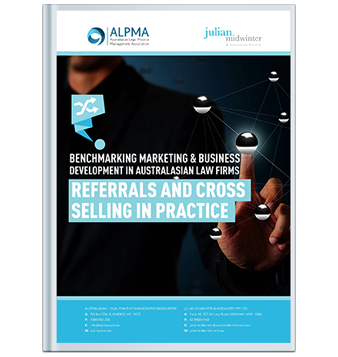Measuring client satisfaction – a win-win-win situation
Preliminary results from our research study with ALPMA, Winning work in a digital world, indicate that 64% of Australasian law firms do not have formal processes in place to measure client satisfaction. This means more than half of firms surveyed spend time, money and effort to win work and clients, but fail to follow-up in a structured manner.
Regardless of the type of professional service your firm offers, measuring client satisfaction provides the opportunity to improve (and refine) workflows, processes, and service quality, and build stronger client relationships. You can improve the long-term health and wealth of your business by putting clients first. ![]()
Client satisfaction feedback can be measured with a simple survey at the end of a project or midway through large projects, and/or periodically during the term of a client relationship (e.g. annually). Focus groups, client panels, and one-on-one interviews (in person or over the phone) can be used to examine service elements in-depth.
A win-win-win situation
Many professional services firms avoid asking for client feedback, either because they fear criticism or because they think they don’t need data to confirm they are doing a great job. Yet feedback processes are relatively simple to administer and, done right, can be a win-win-win situation for your firm: whether the feedback you receive is positive, negative, or neutral, it’s a win.
Positive feedback
Who doesn’t like affirmative feedback that you are doing a good job? Remember, if you don’t ask, you don’t get.
And if your clients are happy with your work, you can request permission to use their comments (de-identified, if required) as client testimonials in your marketing material or tenders and proposals.
Client feedback can also be presented as statistics to represent clients’ positive experience in working with your firm, e.g. “97% of clients would recommend our firm to their professional colleagues”, or “100% of our clients rated our services as excellent value for money”.
By understanding your current clients and what they value about working with your firm, you can tailor your marketing messages to appeal to similar target clients. Further, on the back of positive feedback you can take the opportunity to ask for referrals from that client.
![]() Pro tip: ask the right questions to get the statistics you want to present.
Pro tip: ask the right questions to get the statistics you want to present.
Negative feedback
If your clients raise concerns or provide negative feedback about you or your firm, it’s a warning sign for your firm to take action immediately. Book in a client relationship review meeting to get to the bottom of where dissatisfaction has stemmed from.
It’s important to take time out to listen to feedback. Accept criticism with an open mind, and use it constructively to review the standard of your work and test the robustness of your client service processes.
And if you don’t believe the negative feedback is justified, i.e. you feel you’ve done your best work and provided first-rate service, then maybe this is the type of client you want to avoid.
Ultimately, value the fact that a client is being honest and frank with you. Clients should feel that if there is a problem, your firm wants to know about it, deal with it, and rectify issues in a timely manner.
![]() Pro tip: never ask for feedback and then not do anything with it – especially if the comments are negative.
Pro tip: never ask for feedback and then not do anything with it – especially if the comments are negative.
No feedback
You may not receive any feedback from clients. But this certainly doesn’t mean you should stop asking for it. Asking for feedback sends powerful messages that:
- you care about what your clients think
- you’re proactive and always looking to improve.
Silence from a client is not necessarily a bad sign. But if you consistently fail to receive responses to your surveys, consider whether you’re asking the right questions, too many questions, or in an appropriate manner.
![]() Pro-tip: if possible, have someone who is not involved in the work itself send the survey, to encourage honest and open ratings and commentary (external consultants are great for this).
Pro-tip: if possible, have someone who is not involved in the work itself send the survey, to encourage honest and open ratings and commentary (external consultants are great for this).
Get started
Put in place formal processes around asking for and actioning client satisfaction feedback:
- Decide which format and structure works best for your firm (it will depend on your objectives): one-off or periodic surveys, one-on-one interviews, focus groups, or a mix of some or all of these.
- Consider whether the feedback process should be administered internally, or by external consultants.
- Determine the timing of requesting feedback – e.g. at the end of a matter, midway during a project, annual (or a combination).
- Develop the right questions to give insight into areas such as:
- quality of service
- quality of work
- timeliness
- value for money
- communication
- responsiveness
- availability of partners
- how likely the client is to recommend you
- what other services your client might need in the next 12 months (this is your opportunity to cross-sell or promote your other services).
Don’t delay – get the competitive edge over other firms and start building your feedback library today.
We can help, please get in touch.
Select articles
Feature article

Tender readability – tips to improve your tender presentation and some tender presentation no-nos
Tender readability remains a problem for some in the 21st century. I still see submission documents that cling to a handful of really old hat tender presentation and formatting techniques. I suspect this is because some of these ‘rules’ are viewed as being more appropriate to a ‘formal’ style of document such as a tender. […]


